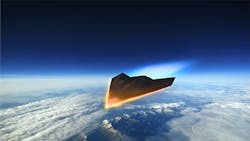Hypersonic weapons will present severe technological challenges for ruggedized electronics
The Military & Aerospace Electronics take:
23 April 2019 -- Hypersonics represent a variety of technological challenges, particularly for electronics and electro-optics manufacturers, to protect against chock, vibration, and extremes in electronics cooling and thermal management that non-hypersonic weapons rarely face.
It's not entirely clear what kinds of acceleration and shock that hypersonic weapons with ruggedized electronics must deal with. A bullet shot from a gun, for example, travels at about 1700 miles per hour, or Mach 2.2. Hypersonic weapons go at speeds twice that.
Acting U.S. Defense Secretary Pat Shanahan recently sounded the alarm that the U.S. military "is not moving fast enough to stay ahead" of rivals China and Russia in space, citing advances in a several technologies, especially hypersonics.
John Keller, chief editor
Military & Aerospace Electronics
Ready to make a purchase? Search the Military & Aerospace Electronics Buyer's Guide for companies, new products, press releases, and videos
